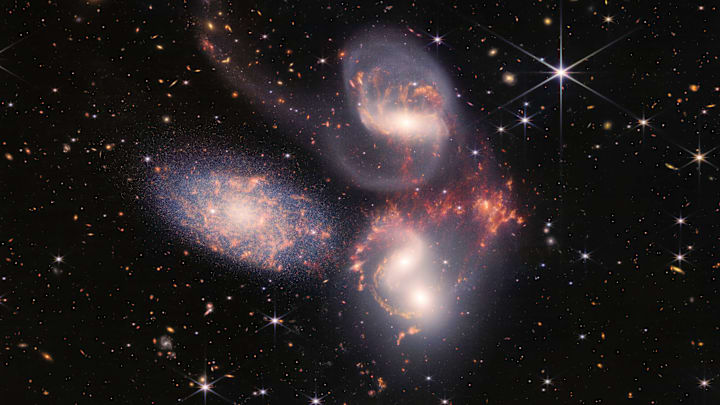People have a lot of weird misconceptions about space (thanks, Hollywood). Here are a few myths about the universe and their real explanations—and we hope you like NASA, because they're going to come up a lot.
1. The Sun is on fire.

When some people picture the Sun, they imagine something like a campfire or an object on fire. But the Sun is actually a ball of gas. It burns thanks to nuclear fusion, which happens in its core. Every second, 700 million tons of hydrogen gets converted into 695 million tons of helium. When this happens, energy is released as gamma rays, which get converted to light. So, the Sun emits light and heat, but it's not on fire, because there's no oxygen involved.
2. The Sun is the only star that has planets.

Experts now believe that most of the stars in our Milky Way have planets surrounding them. Any planet that's found outside of our solar system is known as an exoplanet, and we can be pretty sure that they exist because they affect the way a star appears. One of the most common ways to detect exoplanets is to look for a decrease in light from certain stars at various times, which would indicate that a planet is passing in front of the star, affecting how the light appears to us.
3. Mercury is the closest planet to the Sun, so it's the hottest.

Distance from the Sun actually has little to do with the average temperature on a planet. Venus (the second planet from the Sun) is the hottest planet in the solar system, but that's because of its atmosphere, which contains mostly carbon dioxide and some nitrogen, making it very thick. Throughout the year the surface of Venus remains at a temperature of about 462°C. The surface of Mercury, on the other hand, has a lot of temperature variations. It can be as cold as -173°C at night, and during the day it might reach 427°C. Mercury has a very thin atmosphere, which is why there's so much variation in temperature.
4. People explode in space.

Space is a near-vacuum, which means that people can't survive out there for more than a few minutes—but exploding isn't a concern. A body exposed in space will expand and bloat, especially the air in the lungs and the water in body tissue, but human skin is actually tight enough to prevent exploding. A person exposed to space would eventually die when circulation stops, after dissolved gases in the blood form bubbles and block flow. Basically, it's like an extreme version of "the bends" that divers can get.
5. In the 1960s, NASA spent millions developing a pen that would write in space.

This is a popular myth on the internet—and even in one episode of The West Wing. People tend to use this as a comparison between NASA and Soviet astronauts, who were smart enough to just bring pencils. But NASA used pencils as well, and they have the receipts to prove it. In 1965, NASA placed an order for 34 mechanical pencils from Houston's Tycam Engineering Manufacturing Incorporated. There was an independent company, the Fisher Pen Company, that developed a space pen for around $1 million. And later, both NASA and the Soviets started using Fisher's anti-gravity space pen (it was a great pen).
6. In space, you experience zero gravity.

Gravity is considered the most important force in the universe, and it doesn't just go away when we leave Earth. Gravity is necessary for everything from the Moon's ability to orbit the Earth to the Sun staying put in the Milky Way. What astronauts actually experience in space is what NASA calls micro-gravity. It has nothing to do with the actual strength of gravity, which is only very slightly less on the International Space Station. It's because astronauts are constantly falling, so they seem weightless.
7. Black holes are like vacuums.

As we learn more and more about black holes, experts are more likely to compare them to Venus flytraps than vacuums. Black holes don't suck up everything nearby; instead, they sit pretty dormant, then if a star approaches it and gets too close, the black hole becomes active. And still, only some of the objects nearby get ripped apart by the black hole.
8. The Moon orbits Earth once a day.

It takes about 27.3 days for the Moon to orbit Earth. This is known as a sidereal month. It's worth noting that the Moon's orbit isn't considered regular—it has variations, and there are upwards of five different months that astronomers recognize.
9. There's a dark side of the Moon.

As the Moon is orbiting Earth, it's also rotating on its axis, so we're always seeing the same side of the Moon. But the opposite side isn't dark: it gets the same amount of sunlight as the other side.
10. A light-year measures time.

It actually measures distance. NASA defines a light-year as "the total distance that a beam of light, moving in a straight line, travels in one year." Light travels at around 300,000 kilometers per second, so a light-year is around 10 trillion (10,000,000,000,000) kilometers.
Be sure to subscribe here for more Mental Floss videos.
This story was republished in 2019.
